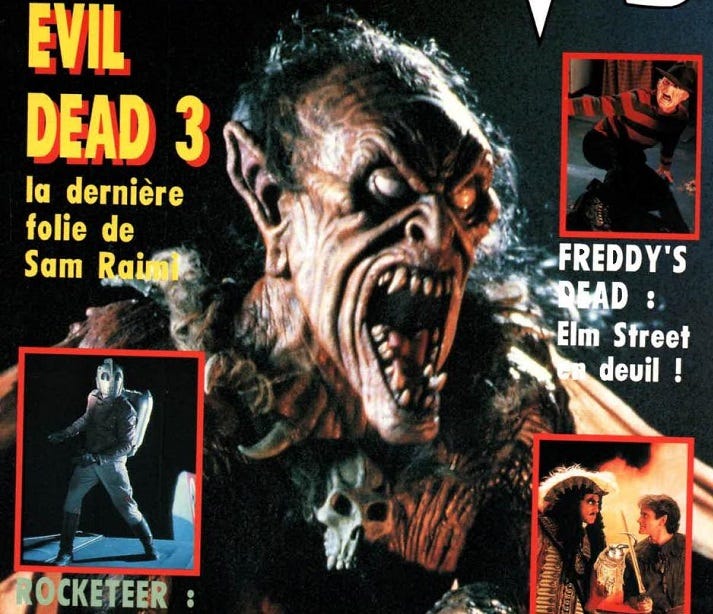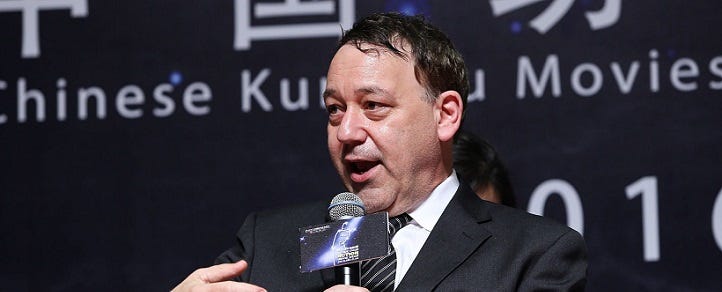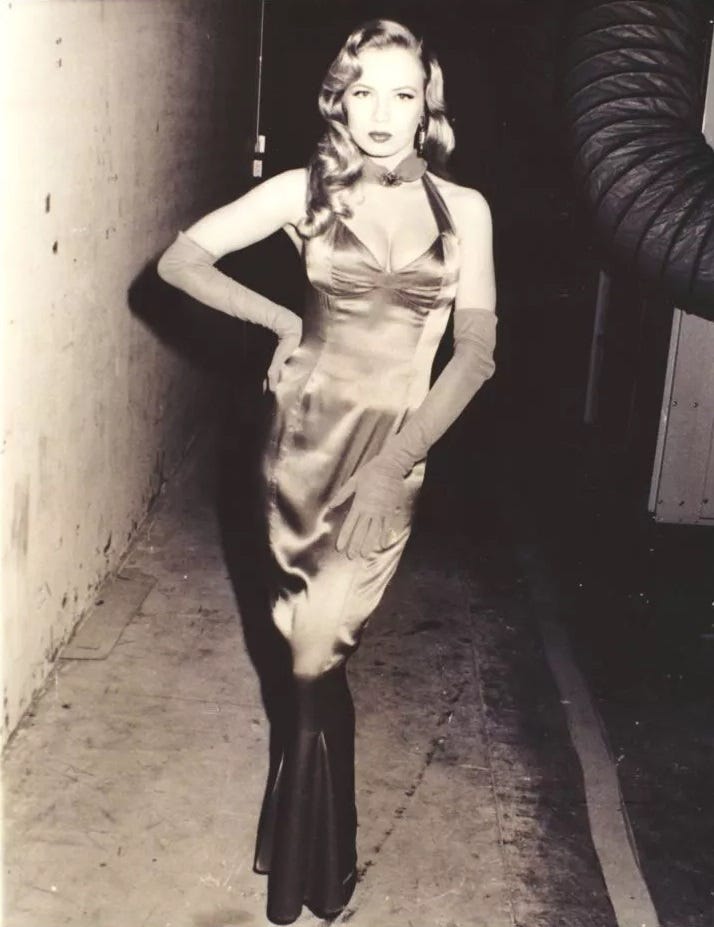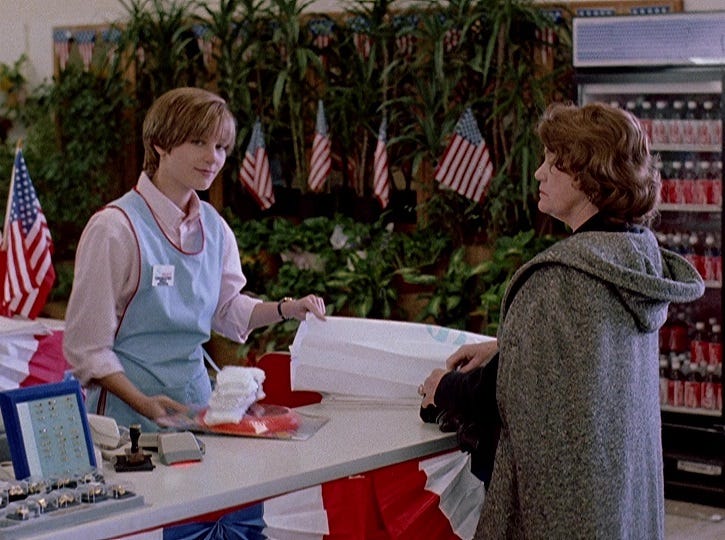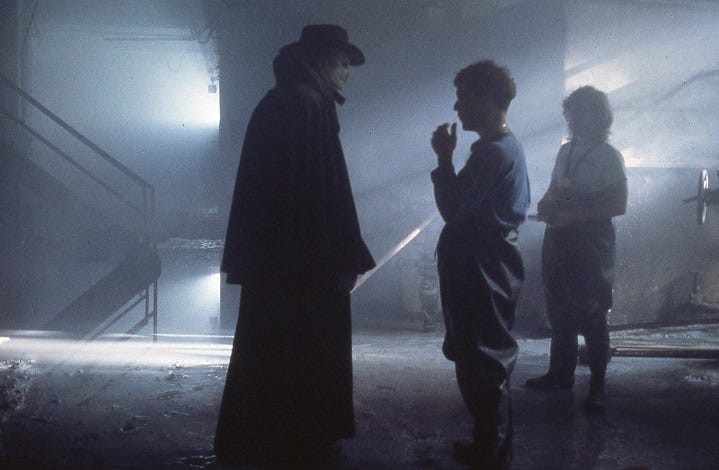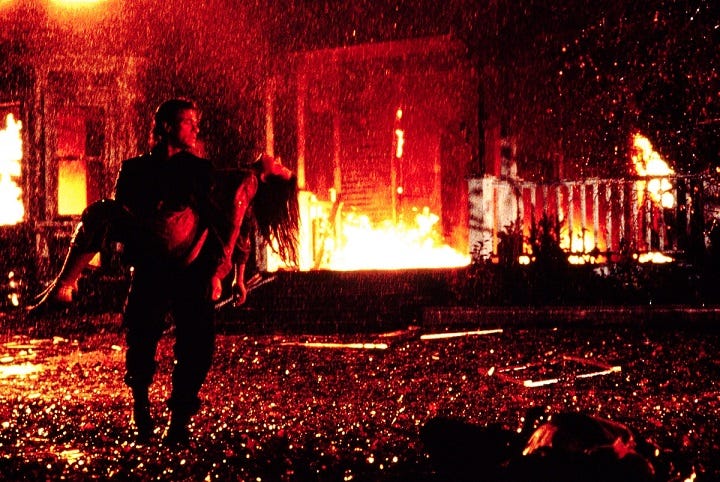Revue is the French word for magazine. Not even the Fangoria magazine had referred to Army of Darkness as just Evil Dead III on any of their covers. In the May 1987 issue (#47) of the above French magazine, Mad Movies, there was a feature on Evil Dead II where I was instantly reminded of the fact that Sam Raimi wanted Ching Siu-Tung to work as a wire consultant for Spider-Man (2002). Sam is such a huge fan of Hong Kong cinema that he hired Ching’s assistant, Dion Lam, to work on Spider-Man 2 (as seen below). The difference was that Dion was credited. H.K. film fans, including the French ones, have detected similarities between Evil Dead II and Ching’s A Chinese Ghost Story (1987).
Mark Shostrom, one of the special effects artists on Evil Dead II, actually grew up in H.K. during the 1970s. He speaks fluent Cantonese. In the 47th issue of Mad Movies, he remembered that Sam Raimi was fixated with getting the wirework on Evil Dead II just right (especially hiding the wires from being seen). It wouldn’t be a stretch to assume that Mark had gone to H.K. to get some advice from Ching while the latter was working on A Chinese Ghost Story in 1986. People have often cited Ching as being inspired by Raimi but A Chinese Ghost Story was actually released in H.K. before Evil Dead II was.
Back to the May 1987 issue of Mad Movies, Sam Raimi talked about wanting to do Darkman with the Coen brothers. As it panned out, Joel and Ethan got to appear in the movie but their involvement as developers remained uncredited. There is a similar issue of giving credit where its due on Evil Dead II, the scene where Ash’s hand gets possessed was inspired by Sammo Hung’s Encounters of the Spooky Kind (1980) but Raimi never mentioned it in his interview for Mad Movies despite mentioning other examples: The Wizard of Oz, The Shining and The Three Stooges. When talking about censorship, Raimi said: “When we show the shadow, it's a deliberate choice. There was too much blood. I cut maybe three moments where Bruce Campbell hits a demon: the severed head that bites him and the decapitation of the guy in the central room. In particular, I took out a part of this scene in which the undead, after losing half of his face, is looking for the missing part by fumbling with his hands. He can't realize that it's gone.”
Fellow Hong Kong film fan Joss Whedon was influenced by that last part when writing a scene for Alien: Resurrection. Speaking of H.K. films, Joss originally wanted Chow Yun-Fat to play the role of Christie but Chow’s manager (Terence Chang) didn’t think that the character was anything more than an action figure. Chow was even referenced in an episode of Whedon’s Angel TV series. Chow’s regular collaborator, John Woo, had his first Hollywood film executively produced by Sam Raimi. Back to A Chinese Ghost Story, that also had a tree demon like in Evil Dead II. Raimi said: “We had a rubber tree with someone inside of course. You can see him from the inside from time to time when he's at the window! For the rest, we had real branches animated by two people. The house is a model.”
Raimi talked about special effects that he wasn’t able to achieve: “In the first version of the script, I had planned a completely different scene instead of the girl being attacked by the vines. Originally, she managed to escape in a car, picked up speed over the bridge and fell back into the water. She sank to the bottom where there was another car with a skeleton inside. She swam towards the surface while the camera showed the bones coming to life. Then she was sucked into a whirlpool. Things became calm and suddenly a geyser of blood sprang up from the water and her skeleton came back up!”
Raimi talked about something else that went unrealized: “I just finished a script with the Coen brothers, a film for Fox, Tales of Manhattan - five films in one. I'll shoot one sketch, the Coens a second, Spike Lee the next and David Byrne and Robert Townsend the last ones. Tales of Manhattan is a romantic comedy.”
In The Evil Dead (1981), there was a scene where music is timed to Ash slapping Linda from left to right. This echoes a scene in Sammo Hung’s The Victim (1980) where music is timed as Sammo looks from left to right. In the January 1990 issue (#63) of Mad Movies, I had read an anecdote from Brian Yuzna that reminded of the ordeal that Sam Raimi went through over Evil Dead III (1992) because there was a stigma that stipulated that hardcore horror film-makers can’t really be embraced in mainstream culture. In the case of Evil Dead III, the title had to be changed to Army of Darkness. It was filmed in the summer of 1991 like another movie that Raimi had worked on but one that he was uncredited for - The Nutt House. No, not nut nor nutty…just nutt. In the February 1993 issue (#43) of a French magazine called Impact, Traci Lords said: “It's a wacky comedy co-produced by Sam Raimi. On the set, I had a lot of fun, especially with Bruce Campbell, despite the differences between the director and the production. They really didn't have the same point of view on the script. To repair the damage, Sam Raimi shot a few sequences. Currently, the problems continue. Given the result, the producers have been arguing and no one knows exactly where the film is!”
Sam Raimi could identify with the struggle that Traci Lords had from being an X movie performer to trying to break into the mainstream. It’s the same thing for the aforementioned Brian Yuzna. When talking about Honey, I Shrunk the Kids (1989), he said: “It was a childhood idea. Stuart Gordon and I wanted to make a film for children. This story of miniaturized kids who have to cross the garden to get home was perfect. We proposed it to Disney from the start. Then Honey, I Shrunk the Kids was rewritten many times and also suffered from multiple changes in studio policy. I finally built all the sets and designed the special effects. 80% of the film is faithful to our project. But the constraints imposed by Disney were new to us, who were used to small productions. There were a lot of conflicts of interest. A week before filming, Stuart had to resign: too much tension, literally and figuratively. Shortly after, I left the production in turn, leaving Disney to finish the film.”
In the January 1993 issue (#81) of Mad Movies, Bruce Campbell talked about his final Evil Dead film with Sam Raimi: “The American distributor, Universal, considers that the ending filmed by Sam Raimi is not satisfactory. The managers have a hard time accepting that the evil film is the culmination of a series. They absolutely do not want us to connect Army of Darkness, which is the American title of Evil Dead III, to Evil Dead I and II. For them, these are two cheap gore films, and they want the public to avoid that connection. But, already, Sam Raimi, Robert Tappert and I are thinking of an Evil Dead IV that would take place in the future. A primal Evil Dead in which Ash would be a savage - a primal being in an excessively civilized world.”
For those who saw the apocalyptic ending, that makes no sense unless the idea was to compensate by making a sequel to the other ending where the future is essentially like Demolition Man. Anyway, Bruce Campbell also said: “The less gory aspect of the film is an economic fact. When, for the first Evil Dead, you only invest $350,000, and this money comes from the pockets of people who have nothing to do with the world of cinema and who can't impose anything on you, you do as you please. You do what you want to do without any restrictions. For Evil Dead II, we suffered from the intervention of the censors. The film cost $3.5 million, the producer wanted to release the film in as wide a circuit as possible and a possible ban for under-17s would have made him very nervous. To benefit from a release worthy of the name, we had to cut 17 minutes of scenes. But Sam Raimi is used to this kind of thing. On Darkman, following sneak previews, he cut a sequence where Larry Drake made love to gold bars. There is a direct correlation between the intensity of a film and its budget. When you have little or no money, you make Henry: Portrait of a Serial Killer. When you have a big budget, you make E.T. or something like that. For this reason, Evil Dead III is more stingy with gory special effects. On the other hand, Sam Raimi does not want to remake the same film, with the same tricks, all his life.”
Evil Dead III was not the first time that Raimi had worked for Universal. They were the overlords of his Darkman (1990), and they were also the thorn in his side when they produced John Woo’s Hard Target (1993). In the November 1990 issue (#68) of Mad Movies, Raimi was asked about working for a major Hollywood studio: “A good experience! I had, of course, a different creative point of view than they did, but we finally came to an agreement. At times, however, I regretted having lost in an argument, having given up ground. In fact, Darkman is the combination of a million decisions. 400,000 during the writing of the script, 400,000 during the shooting and 200,000 during the editing. Overall, I regret only 50 of them. Still, that's a good average. Universal made good and bad decisions. Sometimes the studio people were really nice. Sometimes when they were clearly wrong, they still won the day. Sometimes we disagreed with them and they were right. Actor Colin Friels was imposed on us and he turned out to be excellent in the film! It was only when I started working with him that I discovered his possibilities! Working with a studio also gives you access to the best technicians, the cream of the profession that only money can buy.”
Sam Raimi referenced the Nightmare on Elm Street series: “Like Freddy, Darkman is a badly burned person but he absolutely had to not look like him. The rule was "No Freddy." In Tony Gardner's workshop, we had put up a poster of Freddy covered with a no-entry sign! I absolutely did not want the two characters to be lumped together and accused of imitating anyone. Freddy's look is, for the world's public, that of a modern monster. Darkman belongs to another era. He is more human, more pitiful, more pathetic...”
Like the screenwriters, there have been many editors who have worked on Raimi’s pseudo-comic movie: “Universal first hired David Steven, an Australian, who left before he had even finished the first cut. I don't think he really understood the spirit of the film, the mixture of humour and fantasy. He saw Darkman from a unique angle. Then it was Kathy Weaver's turn. But her Darkman was really too slow for Universal. That's when Bud Smith, the editor of The Exorcist, came in and did most of the work. I came in to finalize his work. There are still a lot of little things I don't like about the film, but the sum of these successive edits is quite satisfying. My goal was to entertain and the audience responds.”
TimeCop (1994) was the second time that Sam Raimi had produced a movie starring Jean-Claude Van Damme. In the November 1994 issue (#92) of Mad Movies, director Peter Hyams. He talked about how he got involved: “Jean-Claude Van Damme himself took the initiative to send me the script for TimeCop. He had liked my few science fiction films. I had never met him before and, frankly, I had not seen a single one of his films. I read the script which I found intriguing. I was interested, but I wanted to find out more about Van Damme's personality before committing. So we met. What a surprise to see someone radically different from the person I had expected! He turns out to be charming, kind, intelligent and funny. Nothing to do with the malicious rumors that circulate about him. We talked at length. He explained to me that he wanted to move on to another genre, that he had had more than enough of pure action and martial arts. TimeCop was to allow him to reach a level he had not yet reached, that of the greatest stars of this style of cinema. According to him, the only way to achieve this is to collaborate with more demanding filmmakers and to find more interesting, richer stories. During one of our meetings, I thought: "If I can get the man I'm having dinner with on screen, there are huge possibilities in this project." Convinced of Van Damme's potential in TimeCop, I reworked the script to bring it into line with my own requirements. I hope I've achieved that goal.”
Interviewer Marc Toullec noticed that the filmmakers who worked with JCVD had suffered from his contact, but Pete said: “I had no difficulty with him. I found him very kind, polite and calm. To become such an athlete and climb the steps of glory from scratch requires an impressive amount of discipline and work. Jean-Claude is capable of a lot, even if not all his films reach the expected level. On a set, he gives his all and works in sync with everyone. Jean-Claude is one of the most honest, most generous, most open individuals, both emotionally and intellectually, that I have met in my life. He can discuss, argue for an entire day to improve a point in the film. And only about the film, not his ego. In fact, we get along so well that we are currently filming Sudden Death together, in which he plays a firefighter who must save his family and 18,000 other people from a terrorist threat during an ice hockey match.”




